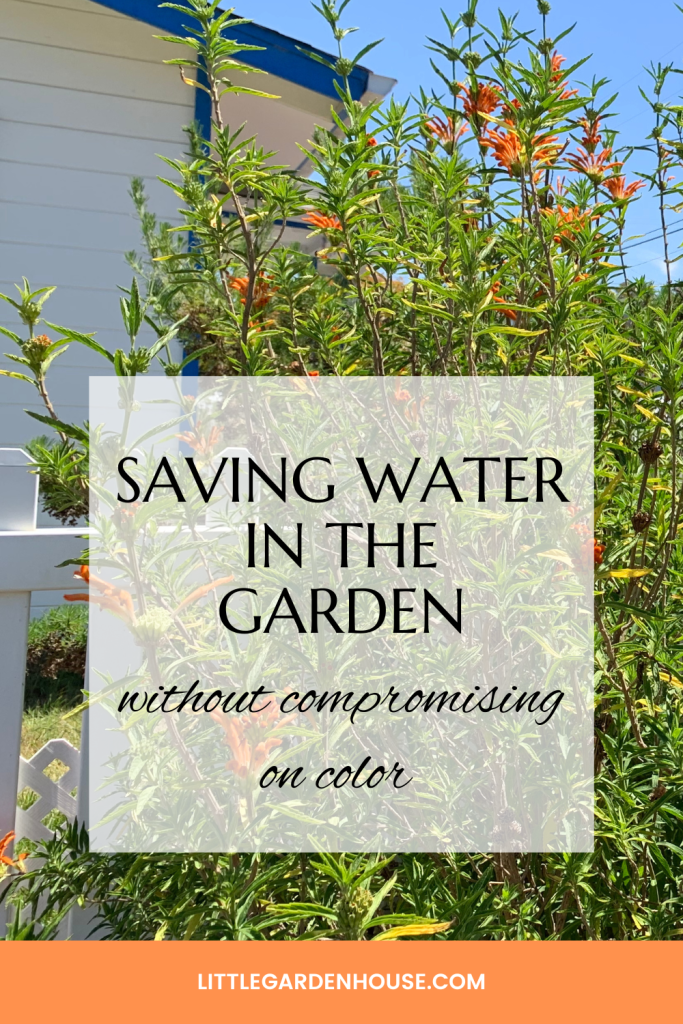Saving water in the garden can lower costs, help the environment and reduce the amount of work involved in maintaining your space. Many ‘water wise’ gardens are heavy on the succulents and desert plants, which can be beautiful but doesn’t have to be the only option. Check out our simple guide below to reducing water use in your garden without compromising on color.
This article contains ads and affiliate links. Pease see our Disclosures and Privacy Policies for more information.
Our simple tips and tricks for saving water in the garden, can help you to have a sustainable, water friendly approach to gardening without compromising on beauty. You do not have to choose between garden impact and sustainability.

1. Consider a gradual transition by starting small
Transitioning to a water wise garden does not have to be all or nothing. Consider starting small by choosing an area of the garden to try out these tips. As this part of your garden gets established, you will be able to see what works in your space and climate, and then expand these methods across the garden.
We started with the hill on the other side of our fence, this was not an area we would be able to water, so right off the bat we implemented the water wise approach. Now three years later, we are converting more and more of our garden into a low water style.
Map out the dry and wet areas of the garden
You may already be familiar with the water needs of each area of your space. If not, take the time to map out the soil types you currently have and the level of watering that is currently required.
You can choose to start with either an area that holds moisture well, or a dry area. Either way, the goal is not to create a ‘dry garden’ necessarily, this depends on your climate. But that given that garden you have, you can reduce your personal water use.

2. Where possible go Native – Right plant right place
The easiest way to save water in the garden is to plant native plants. There are so many benefits to choosing plants native to your area. But environmentally speaking, native plants are more likely to thrive, self-seed and return year after year with very little intervention from you. Native plants will also likely need less additional irrigation and nutrition. This is because they grow in the natural habitat near your house.
Not sure what to plant? Take a Hike!
Not sure what to plant? Go for a nature hike and take lots of photos, you can then research online or talk to your local nursery. Take note of the kinds of soil and light conditions these plants are growing in and what time of year they are blooming.

3. Where you can’t go Native – Adjust your soil type
Perhaps you live in an area where the Native plants are not what you want in the garden, or you are in a big city and focusing mostly on container gardening, or you simply want more blooms and to save water regardless. Here are some soil amendments that will allow you to achieve your water wise goals.
- Coconut coir – Holds 10* its water weight, and can be added to the soil. It doesn’t hold onto nutrients well so be sure to include lots of fertilizer if you use this. This is our secret to growing pumpkins in the hot california summer.
- Corn Starch – A natural Polymer that will hold onto water in soil, check out our article on using this here.
- Clay – If you are able to get some clay to add to your soil, it will retain water very well. It can become hard to break up once dry.
4. How to Mulch to save water
Once you have adjusted the soil to retain water to the desired amount for the plants you have selected. Or selected plants that once established will not require additional water other than that provided by your climate (Native plants). You can now ensure maximum soil water retention by mulching the soil well. I like to use Kellog organic GroMulch, but any organic mulch will help. Homemade is ideal. We have a small composter and so our homemade compost is reserved for the vegetable beds.
Mulch heavily, atleast a few inches, this will
- Retain water
- Suppress Weeds (further reducing water use)
- Add nutrients to the soil over time as it rots.

5. Plan for drought tolerant blooms
For maximum color all year round, research online which plants will be blooming in each season in your zone. Plan ahead and either order seeds or starters from the nursery. I like to do a mix of annuals, perennials and bulbs year-round.
Regular dead heading of your plants will also ensure maximum blooms.

Final thoughts on saving water in the garden
The key to gardening without wasting water, is to choose the right plants, and to maximize the water retention of your soil. To create a garden that is water wise, take inspiration from the ecosystems around you. Plant what grows naturally in your local climate and find inspiration in similar climates.
For more garden inspiration, check out our small garden ideas here.

